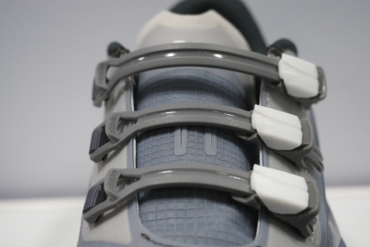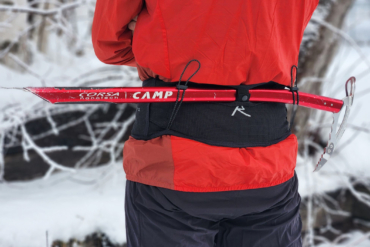HOKA ONE ONE triathlete Sam Holness finished the IRONMAN 70.3 in St. George, Utah, a first for an openly autistic athlete. It’s another achievement toward his larger goal of turning pro.
The London resident arrived in Utah 10 days before the 70.3 IRONMAN World Championships to acclimate to the desert conditions. On race day, the weather delivered rain, lightning, and a sandstorm.
HOKA ONE ONE ambassador Sam Holness completed the IRONMAN course in St. George with a time of 5:44:39. It’s an achievement for anyone, but for a Black athlete on the spectrum, it certainly checked off some firsts.
The day after his triathlon, Sam spent his morning on the cross-trainer to flush lactic acid and then swam in the hotel pool.
“This is not a bucket list. This is what he does,” explained coach and father Tony Holness.

A Family Affair
Tony’s role is a bit of a balancing act. As he puts it, he has to push Sam as a coach, and then, as a father, make sure it’s still something he wants to do.
“When I saw him come in [at St. George] and looked at his numbers, I know he could have done more. That’s the coach’s perspective,” he said. But as a father, “we were just happy to see him safe and sound.”
Sam’s training and well-being are a family affair. His mother helps with daily life and exercises at home. And Tony became a certified IRONMAN coach to help him train.
It turns out athletes on the spectrum respond better to coaches who know there might be some differences in their approach to sports. Sam tapped his own feedback and that of fellow athletes to write a thesis on how coaches can better work with them. It was the last hurdle for completing his sports science degree.
Communication can be challenging for Sam, especially with new faces, and his father often acts as a go-between to facilitate faster conversations during media interviews.
As an adult diagnosed with autism spectrum disorder (ASD), Sam faces stark odds for a full-time job in the U.K., where only 22% of autistic adults are employed. Tony said sports have given Sam confidence, self-esteem, and purpose.
“He loves it. I ask him every week because I’m afraid I’m pushing him into something he doesn’t want to do. And he does it, so we support him. That’s what we as parents can do,” he said.
Autism: The Long Triathlon
He got the name “Super Sam” from his judo sensei.
After standing outside and observing classes for 4 weeks, Sam made up his mind that he wanted to learn judo. Tony explained Sam was given the moniker because he was the first to arrive, the first to hold up his hand for a fight (when the time came), and the last to leave because he picked up the mats. Sam is now a brown belt.
As a neurodiverse athlete, some will point to Sam’s single-minded tendencies as an advantage. And Tony agrees, to a point, because his son is always on time and never complains. However, that perspective misses a lot of little things that come up in training and can disrupt time-based races especially.
Sam learned to ride a bike at age 14 and then learned the form and energy-saving strategy of cycling. He joined a run club at 18, where he learned to relax his shoulders and find a good foot strike, strides, and cadence. Then there was the concept of not overexerting himself, which was aided by setting a goal on a fitness watch and only riding, swimming, or running that far.
Tony has Sam focused on the long triathlon, in part because Sam’s meticulous approach to transitions during a race can lose him time. Losing 30 seconds in each transition during a shorter race only exacerbates that issue.
For some on the spectrum, rain can be uncomfortable — and hard to avoid in London. St. George exposed him to several sensory elements. Some of these were foreign because he trains in the U.K., where nothing compares to the Utah desert.
“I need to improve my cycling, as this was a very technical and difficult course, and also need to practice non-wetsuit racing. The water temperature was 78 degrees,” Sam said. “I don’t think that I could have prepared for the lightning, thunder, or sandstorm, though.”
Perhaps the best summary is the word on the back of Sam’s race kit: determined.

A Simple Training Philosophy
Tony’s approach to training leans toward an emphasis on cardio and reps. Sam also does yoga nightly with his mother to improve his flexibility and aid relaxation. Tony also wants to use Sam’s lack of running and high-impact sports as a reason to build up that experience and, perhaps, take advantage of that lack of wear and tear on his body.
“We have a simple philosophy. Triathlon is an aerobic sport, so we get him to go faster for longer,” Tony said. “We do a lot of trail running, hill reps, and rowing.”
Sam got to meet and train with rower-turned-triathlete Nikki Bartlett in St. George. “We swam a few lengths and got a few racing tips from Nikki,” Sam said. “The best part was that Nikki gave me one of her swim caps from Tokyo. It was so kind.”
They rode Snow Canyon together and got in some tips for the pool work. Afterward, Sam rowed for 20 km.
Tony called the world championships race a big benchmark and already knows how Sam can improve next time. “He needs to be braver on the bike, and I know he should have gone faster … but it’s one of the harder courses around. He’s done good,” Tony said.
The HOKA Relationship
He raced St. George in HOKA Carbon X 2 shoes, and he trains in the Rincons as well as the new Bondi X. The introduction of a carbon fiber plate into the max-cushioned trainer is part of HOKA’s approach to democratizing carbon for more than just race days and enabling more runners to “level up” their training.
That’s a quick change from just 2 years ago when Tony first approached a HOKA booth during a race and asked if they’d give Sam a pair of the yet-released Carbon X shoes to race in. Tony explained he was once a sales guy and has no qualms about asking for things. He wasn’t shy about pointing out Sam’s unique position compared to the rest of the very white triathlon scene.
He didn’t get the shoes then, but it started a conversation and a relationship with the brand that showcased Sam as part of its series celebrating all types of runners.
In 2020, that progressed to an ambassador role with HOKA, which helped him compete in the triathlon world championships despite not holding a professional license. HOKA opened a door, and Sam did not disappoint.
Future Goals
Sam has his sights set on getting a pro license in 2-3 years, with ideas of how to get faster in each discipline and drop his marathon time to less than 3 hours.
“I am only 28 years old and will be upping my training like a pro next year,” Sam said. “Over the winter, I will be doing trail running, mountain bike, and gravel cycling to build up my strength and aerobic capacity. I do this full-time; it’s my job and passion, and it’s great.”
For 2022, Sam’s primary objective is a full slate of events after so many events were canceled due to COVID-19. HOKA sponsors the NN Marathon Rotterdam, where Tony expects the flat course will serve as an early opportunity for Sam to put up his best numbers on the run — and potentially his goal of finishing a marathon under 3 hours.
“The winter is about strength and doing all the things athletes don’t like to do,” Tony said. “Sam does like it though — straight up.”
Ideally, a month in Spain to train in drier climates might benefit the whole family, Tony suggested. Otherwise, the blustery weather in England will suffice for some gravel biking in addition to treadmill workouts.
Tony explained the training ahead: “It’s about getting Sam more used to more sensory things and making it muddier and harder. All of this is about building character and building toughness, so when it comes to the fast races, he can do well in them. And it’s fun. It’s gotta be fun.”

This article is sponsored by HOKA ONE ONE. Find out more about its Bondi X shoes on the brand’s website.






